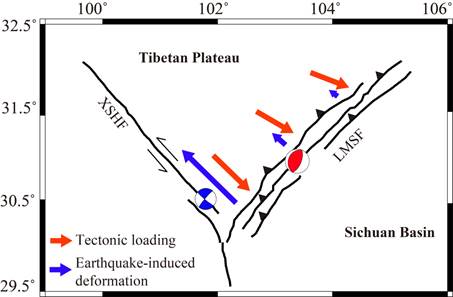Chang Liu 1*, Peiyu Dong2, Bojing Zhu3, and Yaolin Shi4
1 State Key Laboratory of Marine Geology, Tongji University, Shanghai, China
2 Institute of Seismology, China Earthquake Administration & Hubei Earthquake Administration, Wuhan, China
3 Yunnan observatories, Chinese Academy of Sciences, Kunming, China
4 Key Laboratory of Computational Geodynamics, Chinese Academy of Sciences, Beijing, China
Abstract: The 2008 Wenchuan Mw 7.9 earthquake unilaterally ruptured the Longmen Shan fault (LMSF) along the eastern Tibetan Plateau. The earthquake rupture propagated about 270 km northeastward, whereas it propagated only about 20 km southwestward along the strike of the fault. Although a significant attention has been paid to the question of predominantly unilateral propagation, the primary reasons for this type of propagation remain unclear. In this research, we examined the change of Coulomb stress along the LMSF caused by the historical earthquakes near and on the LMSF during the period from 1725 to 2008. We found that the 14 preceding large earthquakes (M ≥6.5) on the Xianshui He fault (XSHF) cast a stress shadow on the southwestward (SW) segment of the LMSF, which was not activated by the 2008 Wenchuan earthquake rupture. The 1970 Dayi (Ms 6.2) earthquake on the SW segment of the LMSF contributed significantly to this stress shadow. Compared with the segment of the 2008 Wenchuan earthquake rupture, this stress shadow caused strong stress contrasts of −214 kPa, −22 kPa, and −80 kPa in the seismic gap of the very SW segment of the LMSF, the rupture zone of the 2013 Lushan earthquake, and the seismic gap between the 2008 Wenchuan and 2013 Lushan (Mw 6.6) earthquake ruptures, respectively. Stress contrasts in these values were consistent with tectonic loading over 165 years, 17 years, and 62 years, respectively, by integrating an interseismic stress-loading rate of 1.3 kPa/a. We proposed that this stress shadow might have created a barrier at the SW segment, preventing the earthquake rupture from propagating southwestward, while also encouraging predominantly northeastward propagation. These findings are helpful for assessing seismic hazards in the LMSF and also could have important implications for understanding the interaction processes of other fault systems globally.

Full article: https://doi.org/10.1029/2018JB015633


